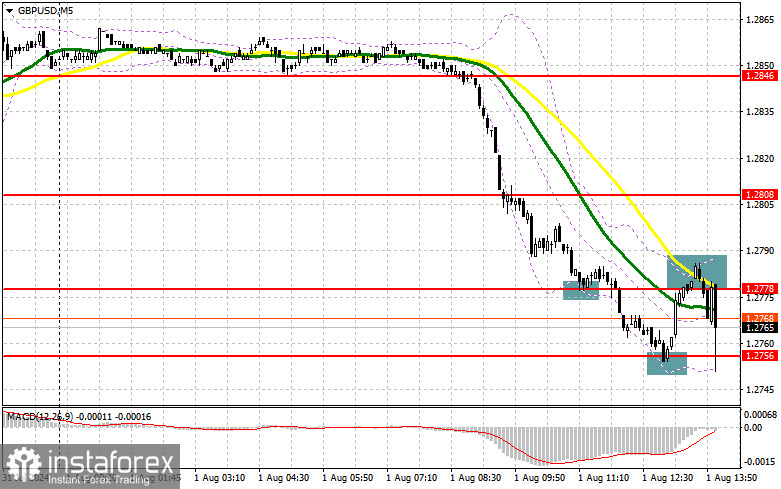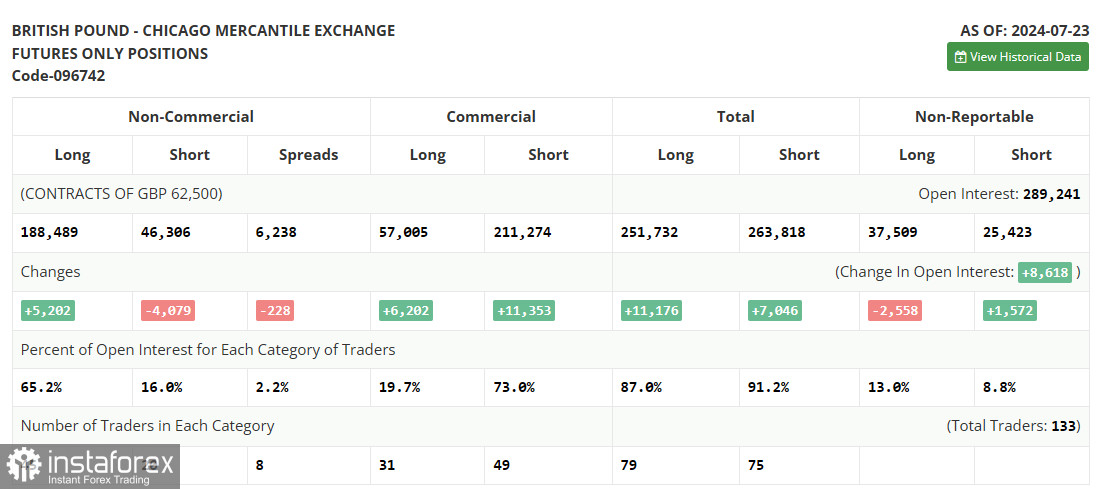In my morning forecast, I highlighted the levels of 1.2778 and 1.2756 and planned to make market entry decisions based on them. Let's look at the 5-minute chart and understand what happened there. A decline and the formation of a false breakout at 1.2778 allowed for market entry, but the pair did not rise, unlike the purchases from the 1.2756 level, which resulted in the pound moving up by more than 20 points. Then, a failed return to 1.2778 and a sell signal allowed for another 20 points to be pulled from the market. The technical picture for the second half of the day has been slightly revised.

For opening long positions on GBP/USD:
The Bank of England lowered rates to 5.0%, and that's all for now. Ahead, we have a speech by the Governor of the Bank of England, Andrew Bailey, whose comments could create even more problems for the pound. I discussed this in detail in my morning forecast. Besides Bailey, there are a lot of U.S. statistics to look forward to. It all starts with the number of initial jobless claims and the ISM manufacturing index and ends with changes in construction spending. A weak ISM index will help the pound to recover slightly, while strong data will lead to a new wave of the pair's decline, which I plan to take advantage of. In the case of a fall in GBP/USD, I plan to enter around the significant support at 1.2756, which performed well in the first half of the day. A false breakout formation, similar to what I analyzed above, will provide an entry point with the target of returning to 1.2785 – the new resistance. A breakout and a reverse test from top to bottom of this range will restore the chances for the pound to rise, leading to an entry point for long positions with the possibility of reaching the 1.2817 level. The farthest target will be the area of 1.2853, where I plan to take profits. If GBP/USD continues to decline and there is no activity from the bulls at 1.2756 in the second half of the day, which is more likely, this will lead to a drop and an update of the next support at 1.2734, increasing the chances of a larger pair decline. Therefore, only the formation of a false breakout will be a suitable condition for opening long positions. I plan to buy GBP/USD immediately on a rebound from the 1.2703 low with a target of a 30-35 point correction within the day.
For opening short positions on GBP/USD:
Sellers control the market, and any softness in Bailey's words will lead to a new wave of the pound's decline. In the case of a bullish reaction, I plan to act on selling only after forming a false breakout around the new resistance at 1.2785, which will provide an opportunity to open new short positions to continue the bearish trend with the target of updating the support at 1.2756, which has already performed well today. A breakout and a reverse test from the bottom to the top of this range will hit buyers' positions, leading to stop orders being triggered and opening the way to 1.2734. The farthest target will be the area of 1.2703, where I will take profits. Testing this level will only strengthen the new bearish trend. In the scenario of GBP/USD rising and no activity at 1.2785 in the second half of the day, buyers will get a good chance for a larger upward push – especially in case of uncertainty within the Bank of England about when to lower rates further. In this case, I will postpone selling until a false breakout at the 1.2817 level. If there is no downward movement, I will sell GBP/USD immediately on a rebound from 1.2853, but on

In the COT report (Commitment of Traders) for July 23, there was an increase in long positions and a decrease in short ones. The focus was on the Federal Reserve meeting, where rates will definitely not change, but during which investors hope to hear more arguments for a cut in September this year. The Bank of England's decision, which will also be published soon, could cause a lot of noise. Economists expect the British regulator to cut rates this summer, which in theory should weaken the British pound against the U.S. dollar even more, so counting on the return of the bullish market observed in June is clearly not worth it in the near future. The latest COT report indicates that long non-commercial positions increased by 5,202 to the level of 188,489, while short non-commercial positions fell by 4,079 to the level of 46,306. As a result, the spread between long and short positions fell by 228.
Indicator signals:
Moving Averages
Trading is conducted below the 30 and 50-day moving averages, indicating a possible continuation of the pair's decline.
Note: The period and prices of the moving averages are considered by the author on the hourly H1 chart and differ from the general definition of classic daily moving averages on the D1 daily chart.
Bollinger Bands In case of a decline, the lower boundary of the indicator, around 1.2756, will act as support.
Indicator Descriptions:
- Moving average: Determines the current trend by smoothing volatility and noise. Period 50. Marked in yellow on the chart.
- Moving average: Determines the current trend by smoothing volatility and noise. Period 30. Marked in green on the chart.
- MACD indicator (Moving Average Convergence/Divergence): Fast EMA period 12. Slow EMA period 26. SMA period 9.
- Bollinger Bands: Period 20.
- Non-commercial traders: Speculators such as individual traders, hedge funds, and large institutions that use the futures market for speculative purposes and meet certain requirements.
- Long non-commercial positions: Represent the total long open position of non-commercial traders.
- Short non-commercial positions: Represent the total short open positions of non-commercial traders.
- Total non-commercial net position: The difference between the short and long positions of non-commercial traders.
 English
English 
 Русский
Русский Bahasa Indonesia
Bahasa Indonesia Bahasa Malay
Bahasa Malay ไทย
ไทย Español
Español Deutsch
Deutsch Български
Български Français
Français Tiếng Việt
Tiếng Việt 中文
中文 বাংলা
বাংলা हिन्दी
हिन्दी Čeština
Čeština Українська
Українська Română
Română

